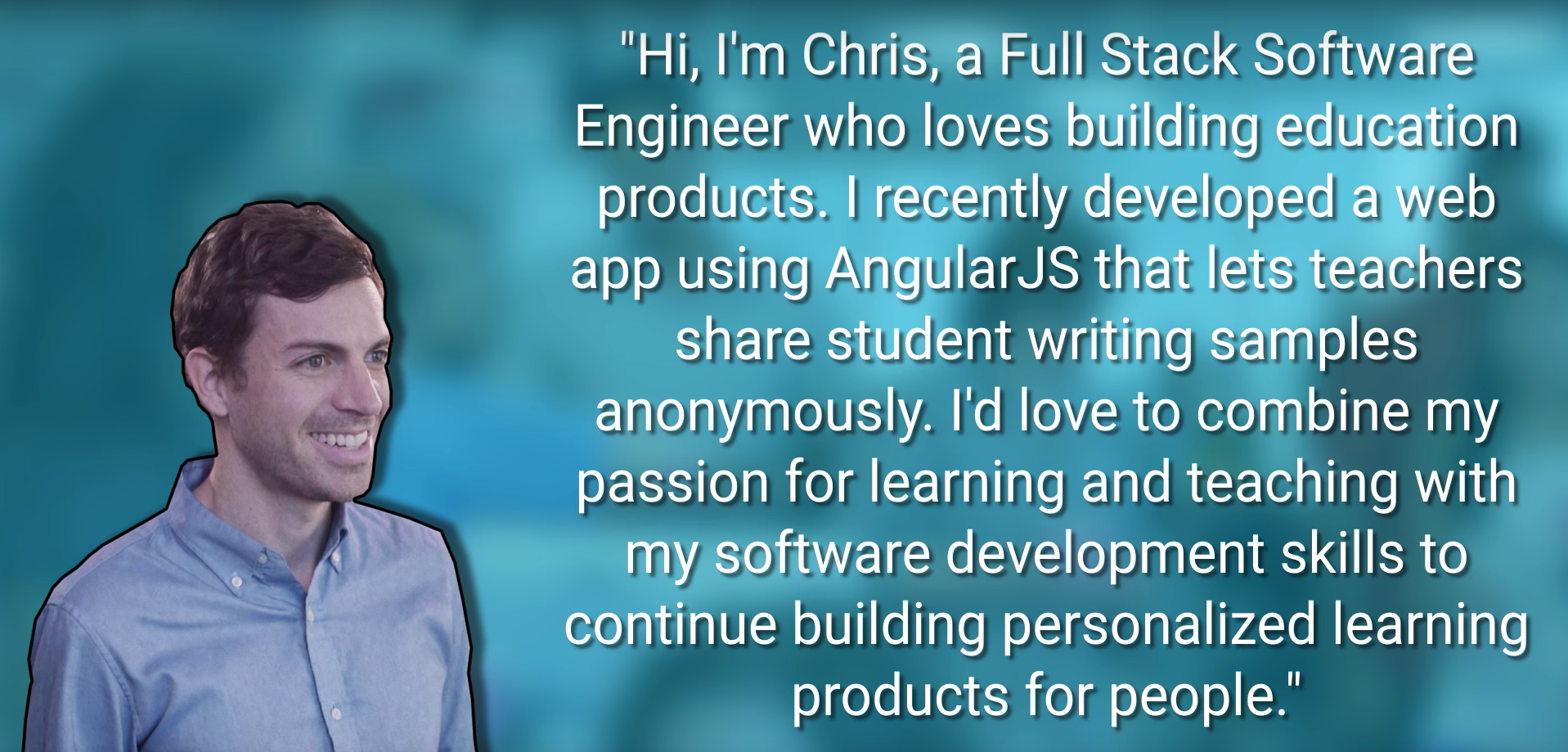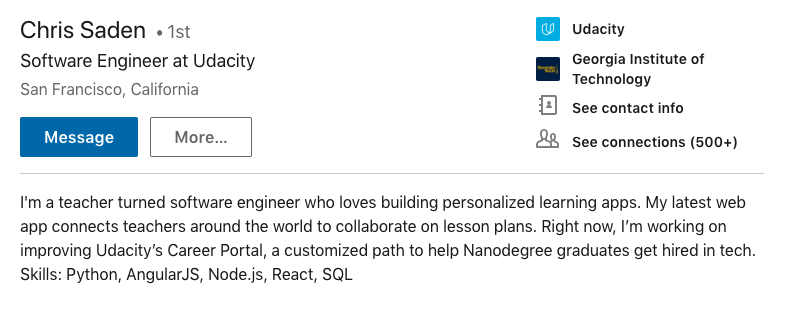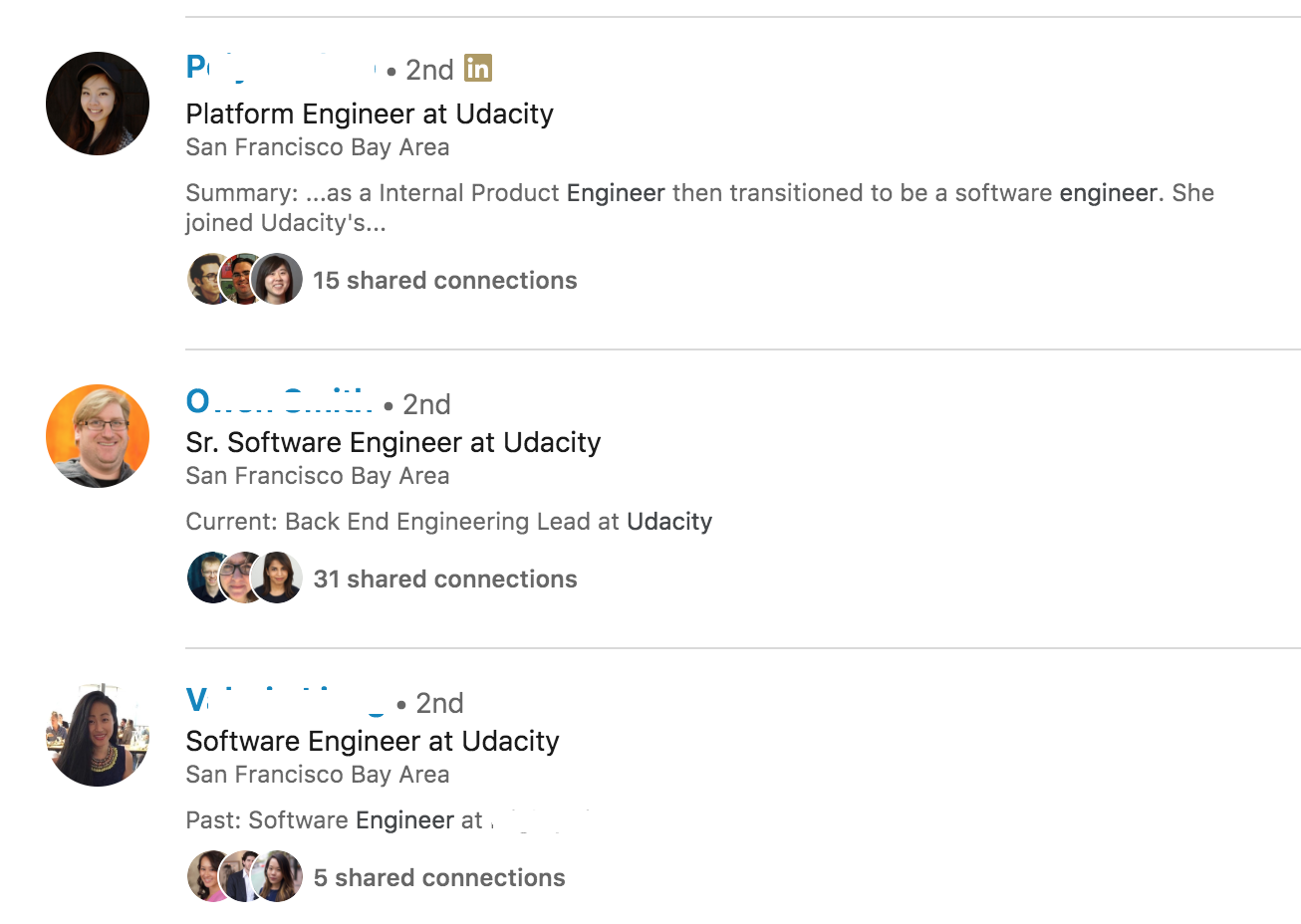# Udacity Linkedin
## Use Your Elevator Pitch on LinkedIn
Let's take another look at Chris's elevator pitch:

> Hi, I’m Chris, a Full Stack Software Engineer who loves building education products. I recently developed a web app using AngularJS that lets teachers share student writing samples anonymously. I’d love to combine my passion for learning and teaching with my software development skills to continue building personalized learning products for people.
Use the same talking points for your LinkedIn summary, which may be the first thing people read on your profile. When recruiters (or anyone else) search on LinkedIn, keywords from your summary contribute to your rank in search results.
### LinkedIn Summary Guidelines
- Keep the summary to 3-5 points maximum.
- Use numbers where possible.
- Always use active instead of passive language.
- Include a call to action so that people are more likely to contact you for more information.
See how Chris uses the same elevator pitch to craft his LinkedIn summary:

## Create Your Profile With SEO In Mind
### Before we continue:
If you already have a LinkedIn profile - fantastic! Use this section to investigate, revise, and improve the highlighted sections.
If you don't have a LinkedIn profile - you will soon! Open up LinkedIn in another browser tab and create an account. You can expect to spend about 10 minutes going through LinkedIn's "Welcome" flow.
### Keywords and SEO
As there are millions of LinkedIn users, you may be wondering how you stand out or are surfaced to recruiters. Below, we dive into the sections of your profile which are essential to SEO (search engine optimization - or optimizing your profile for searches on LinkedIn).
On your LinkedIn profile, more-so than on a resume or other application materials, it is helpful to use keywords specific to the job you are targeting. This is especially true of the words you include in your headline, summary, and current job title. Think of the words that a recruiter might type to search for candidates of your target job and check to ensure they're listed in your profile.
For example, if you were looking for a job developing mobile augmented reality apps, you might want to include words like `engineer`, `iOS`, `Android`, `Unity`, or `3D`.
> Pro Tip: To find keywords to add, read job descriptions of positions you are targeting.
For example, when you search "Udacity Software Engineer" on LinkedIn, you may find similar results to the image below. What do you notice about the search results?

You may have noticed that:
1. All have profile pictures.
2. All have the keyword "software engineer" in their Headline, Summary, and Past Experience sections.
3. All are second connections with the searcher. The people you're 1st, 2nd, and 3rd connections to will be prioritized in your search results. If you want to be surfaced in search results, you'll need to connect with others in your industry to boost your visibility.
## Spend some time getting these essentials right.
### Name
Here you will need to use your real name, not a pseudonym. No `Codergirl42`, no `HireMe McJoberson`, just your real first and last name.
> Pro Tip: You can add former names to your Profile. See instructions from LinkedIn.
### Profile Picture
**Do**
- Upload a picture cropped to your head and shoulders.
- Aim for a high resolution photo.
**Don't**
- No inappropriate or unprofessional items or environments.
- Don't include other people - this is your profile after all!
- No selfies. Someone is willing to take a photo for you, we promise!
### Headline
Your headline should be one of the following options:
- **Your Current Job Title**. This is the simplest but most effective way to optimize SEO; LinkedIn even defaults to suggesting you do this.
- **Your Education**. If you do not yet have a job in your new industry, add your education such as "Data Analyst Nanodegree Graduate." You still include the key term "data analyst".
- **Your Target Job**. Remember when Chris said his job search improved when he finally called himself a software engineer? If you're a Nanodegree graduate with a portfolio of real-world projects to share, feel confident and list your target job title.
### Summary
You should already have your summary, crafted from your elevator pitch, from the exercise with Chris. If you need a refresher, just go back to "Use Your Elevator Pitch on LinkedIn." Your summary should:
- Be written in first person, with a professional but conversational tone.
- Include your key abilities and contributions.
- Include 5 key skills (programming languages, software, etc.) for SEO purposes.
For reference, here's Chris's summary:

## Showcase Successful Work Experiences
The Experience section of your LinkedIn profile should mirror your resume. Ensuring your resume and LinkedIn are consistent will help to build your personal brand.
In our [free course on resume writing](https://www.udacity.com/course/refresh-your-resume--ud243), we provide detailed guidance on how to describe your work experiences in a way that showcases success. Here are some guidelines to keep in mind for both resumes and LinkedIn profiles:
**Be concise.**
- Include only relevant experience.
- Keep each description to 3 bullet points or less.
- At least 1 of these bullet points should demonstrate an individual contribution.
- At least 1 of these bullet points should communicate a project result (success metrics, findings).
**Always convey Action, Numbers, Success.**
- Action - Use active verbs to describe what you did.
- Numbers - Quantify your accomplishments.
- Success - Define each experience in terms of what you learned or achieved.
**Order matters.**
Make sure that your most relevant and most recent experience appears at the top of your profile.
### Accomplishments
You can adapt the "Accomplishments" section of your LinkedIn profile to a wide variety of work experiences and achievements. For example, the "Accomplishments" section for "Projects" is an excellent place to **showcase your Udacity projects!** You can also list the Udacity courses you have taken in the "Accomplishments" section for "Courses."
When describing your projects be sure to include the specific technical skills you learned relevant to your target field. Think about the parts of your Udacity projects that you are most proud of and frame them as successes in your project description. Here are a couple good examples from Udacity alums:
[Kristin, Virtual Reality Developer Nanodegree Program Alum](https://www.linkedin.com/in/kristindragos/) - Notice how Kristin uses the project section to showcase the technologies she has worked with (i.e. Unity, Oculus Rift). She also provides links to visuals for each project, so that it's easy for recruiters and connections to dive deeper into a project that piques their curiosity.
[Michael, Self Driving Car Nanodegree Program Alum](https://www.linkedin.com/in/michael-virgo/) - Notice how Michael uses the "Projects" section to include more details about his experience with autonomous vehicles, and highlights his use of particular models like convolutional neural networks.